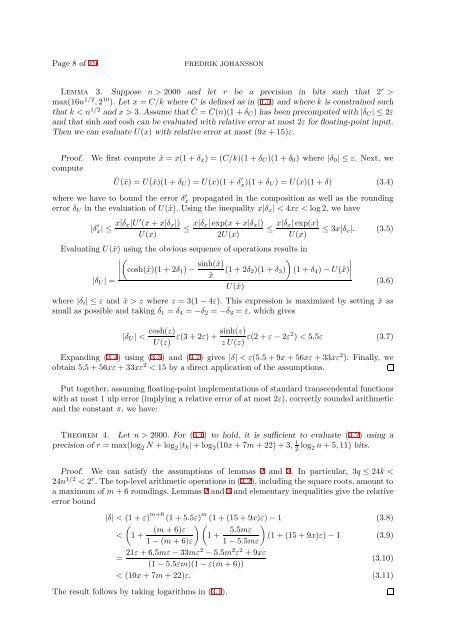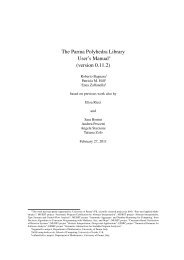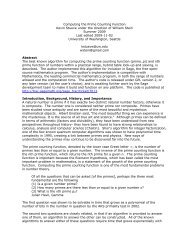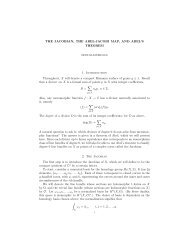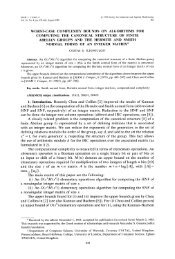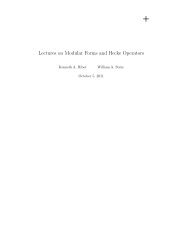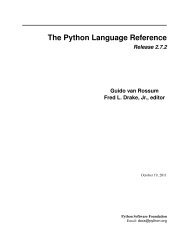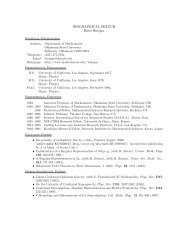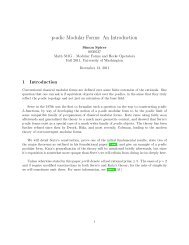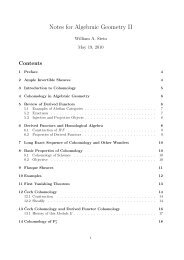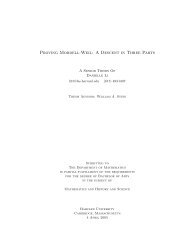Efficient implementation of the Hardy-Ramanujan ... - William Stein
Efficient implementation of the Hardy-Ramanujan ... - William Stein
Efficient implementation of the Hardy-Ramanujan ... - William Stein
Create successful ePaper yourself
Turn your PDF publications into a flip-book with our unique Google optimized e-Paper software.
Page 8 <strong>of</strong> 19<br />
FREDRIK JOHANSSON<br />
Lemma 3. Suppose n > 2000 and let r be a precision in bits such that 2 r ><br />
max(16n 1/2 ,2 10 ). Let x = C/k where C is defined as in (1.5) and where k is constrained such<br />
that k < n 1/2 and x > 3. Assume that Ĉ = C(n)(1+δ C) has been precomputed with |δ C | ≤ 2ε<br />
and that sinh and cosh can be evaluated with relative error at most 2ε for floating-point input.<br />
Then we can evaluate U(x) with relative error at most (9x+15)ε.<br />
Pro<strong>of</strong>. We first compute ˆx = x(1+δ x ) = (C/k)(1+δ C )(1+δ 0 ) where |δ 0 | ≤ ε. Next, we<br />
compute<br />
Û(ˆx) = U(ˆx)(1+δ U ) = U(x)(1+δ ′ x )(1+δ U) = U(x)(1+δ) (3.4)<br />
where we have to bound <strong>the</strong> error δ ′ x propagated in <strong>the</strong> composition as well as <strong>the</strong> rounding<br />
error δ U in <strong>the</strong> evaluation <strong>of</strong> U(ˆx). Using <strong>the</strong> inequality x|δ x | < 4xε < log2, we have<br />
|δ ′ x| ≤ x|δ x|U ′ (x+x|δ x |)<br />
U(x)<br />
≤ x|δ x|exp(x+x|δ x |)<br />
2U(x)<br />
≤ x|δ x|exp(x)<br />
U(x)<br />
Evaluating U(ˆx) using <strong>the</strong> obvious sequence <strong>of</strong> operations results in<br />
(<br />
∣ cosh(ˆx)(1+2δ 1 )− sinh(ˆx) )<br />
(1+2δ 2 )(1+δ 3 ) (1+δ 4 )−U(ˆx)<br />
ˆx<br />
∣<br />
|δ U | =<br />
U(ˆx)<br />
≤ 3x|δ x |. (3.5)<br />
where |δ i | ≤ ε and ˆx > z where z = 3(1−4ε). This expression is maximized by setting ˆx as<br />
small as possible and taking δ 1 = δ 4 = −δ 2 = −δ 3 = ε, which gives<br />
(3.6)<br />
|δ U | < cosh(z) sinh(z)<br />
ε(3+2ε)+<br />
U(z) zU(z) ε(2+ε−2ε2 ) < 5.5ε (3.7)<br />
Expanding (3.4) using (3.5) and (3.7) gives |δ| < ε(5.5+9x+56xε+33xε 2 ). Finally, we<br />
obtain 5.5+56xε+33xε 2 < 15 by a direct application <strong>of</strong> <strong>the</strong> assumptions.<br />
Put toge<strong>the</strong>r, assuming floating-point <strong>implementation</strong>s <strong>of</strong> standard transcendental functions<br />
with at most 1 ulp error (implying a relative error <strong>of</strong> at most 2ε), correctly rounded arithmetic<br />
and <strong>the</strong> constant π, we have:<br />
Theorem 4. Let n > 2000. For (3.1) to hold, it is sufficient to evaluate (3.2) using a<br />
precision <strong>of</strong> r = max(log 2 N +log 2 |t k |+log 2 (10x+7m+22)+3, 1 2 log 2n+5,11) bits.<br />
Pro<strong>of</strong>. We can satisfy <strong>the</strong> assumptions <strong>of</strong> lemmas 2 and 3. In particular, 3q ≤ 24k <<br />
24n 1/2 < 2 r . The top-levelarithmetic operationsin (3.2), including <strong>the</strong> squareroots,amountto<br />
a maximum <strong>of</strong> m+6 roundings. Lemmas 2 and 3 and elementary inequalities give <strong>the</strong> relative<br />
error bound<br />
|δ| < (1+ε) m+6 (1+5.5ε) m (1+(15+9x)ε)−1 (3.8)<br />
(<br />
< 1+ (m+6)ε )(<br />
1+ 5.5mε )<br />
(1+(15+9x)ε)−1 (3.9)<br />
1−(m+6)ε 1−5.5mε<br />
= 21ε+6.5mε−33mε2 −5.5m 2 ε 2 +9xε<br />
(1−5.5εm)(1−ε(m+6))<br />
(3.10)<br />
< (10x+7m+22)ε. (3.11)<br />
The result follows by taking logarithms in (3.1).


